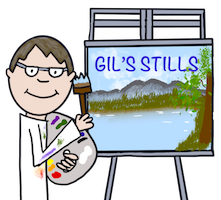A quick index of my work for Season 1
 |
| A Walk In The Woods (c) 4 October 22 Gilbert Blankenship |
 |
| not Mt. McKinley (c) 10 October 2022 Gilbert Blankenship |
 |
| bony Sunset (attempt 2) (c) 17 October 2022 Gilbert Blankenship |
 | |
|
 |
| Winter Moon (c) 5 November Gilbert Blankenship |
 |
| Peaceful Valley (c) 20 November 2022 Gilbert Blankenship |
 |
| Seascape (c) 24 November 2022 Gilbert Blankenship |
 |
| Mountain Lake (c) 3 December 2022 Gilbert Blankenship |
 |
| Winter Glow (c) 11 December 2022 Gilbert Blankenship |
 |
| Snowfall (c)17 December 2022 Gilbert Blankenship |
 |
| Final Reflections (c) 24 December 2022 |
Lessons Learned
- Start with small amounts of paint on the palette. Some sites say only about a capful per color.
- You can always add a little more from the tube - but getting excess back in the tube once your done painting is, for some reason, quite difficult.
- Work from the top down and from far to near
- Plan your layout. Think about the four zones on the canvas/. You can remember them with the mnemonic Have Some More Fun
- Sky
- Horizon
- Mid-ground
- Foreground
- Take your time, with lots of breaks.
- Step back and look.
- Its easier to fix mistakes as they happen - than it is long after they happened
- No mistake is unrecoverable. If all else fails - add another happy tree
- Painting with a friend helps in this process. Discussions strike up, leading to breaks and talks about how to overcome issues as they arise. Plus you get instant feedback on your progress. I especially like the comments that began with:
- "What were you going for with this (points at area of painting)?" (Immediately harkening back to my attempts in 3d grade art I reply - "uhm failure?")
- Or,
- Friend: Oh, you're one of those painters.
- Me: Huh?
- Friend: All your clouds are always in the center of the canvas.
- As you add more layers of paint
- thin the paint a little
- because - "a thinner paint sticks to a thicker paint"
- use a lighter touch
- because - there could be mud in them there colors
- Having more than one of each kind of brush for the project, i.e. multiple 2" brushes is faster
- Less worry about having a clean brush when you change colors
- Less worry about having a dry brush changing colors
- A paint brush full of thinner results in thinner paints (lol)
- Faster swapping between colors - since you might already have a brush that still has that mixture of green and yellow you want to use again
- Having a sense of humor, as well as adventure helps. If you cannot laugh (and learn) at (from) your mistakes, you can never truly rejoice in and enjoy your successes!
- Be careful with your blending of color zones, because a blue sky blended into a yellow sun aura will identify as "green". And that's gonna take one heck of an "all-mighty" happy tree to cover that mistake!
- Use a flat piece of cardboard as a staging pallet. This will help drain some excess oil from your paint. After a few minutes you can easily use a knife to transfer your (now) stiff oils to your palette.
- Everyone "sees" differently. As a beginner, your paintings will not match the inspiration. But as you get better, so will your own interpretation of your inspiration.
- Label and sign your paintings.
- But be careful. If using the back make sure your information won't show through the front
- Remember - In a couple weeks, you may not remember anything about it if it isn't labeled.
 |
| Practice Session (c) 2022 Gilbert Blankenship |
Take this gem for example. I know it was one of my practice sessions - just playing around but, I didn't take the time to label the back. So ... circa winter 2022. Other than that - who knows. I do recall that it was so far off from where I wanted to go I stopped half way through.
Lessons Not Learned
- Palette, Pallet or Pallette?
- How much liquid (insert color) is enough, or too much?
- Why
- do you drive on a parkway, but park on a driveway?
- do you drive under an overpass, but over an underpass?
- when you send something by truck its a shipment; when it's sent by ship its cargo, and when you truck it goes by train?
Bob Ross Books
I like these. They are step by step instructions on how he created the painting. However, there is a caveat. The story goes that Mr. Ross painted 3 copies of each painting for each show. The first was a practice study and was used on set, off camera, as his reference. The second was live, and the third typically given to the station to sell during those fund raising periods. It is the third painting (if I understand correctly) that the books were published from. As such, the books do not always contain everything that you see on screen. For example - they may not contain a listing of all the paints he will use on screen. There are a couple ways to address this depending on how you approach 'the assignment'.
- Just use one, not both book and video, as reference
- Use both, but watch the video first and make notes in the book about any differences (like the use of Burnt Umber in the video - which isn't listed in the book)
- Load your palette with all the paints each time, which could be wasteful (see above note about getting toothpaste, I mean oil, back in the tube).
- Gil



Comments
Post a Comment